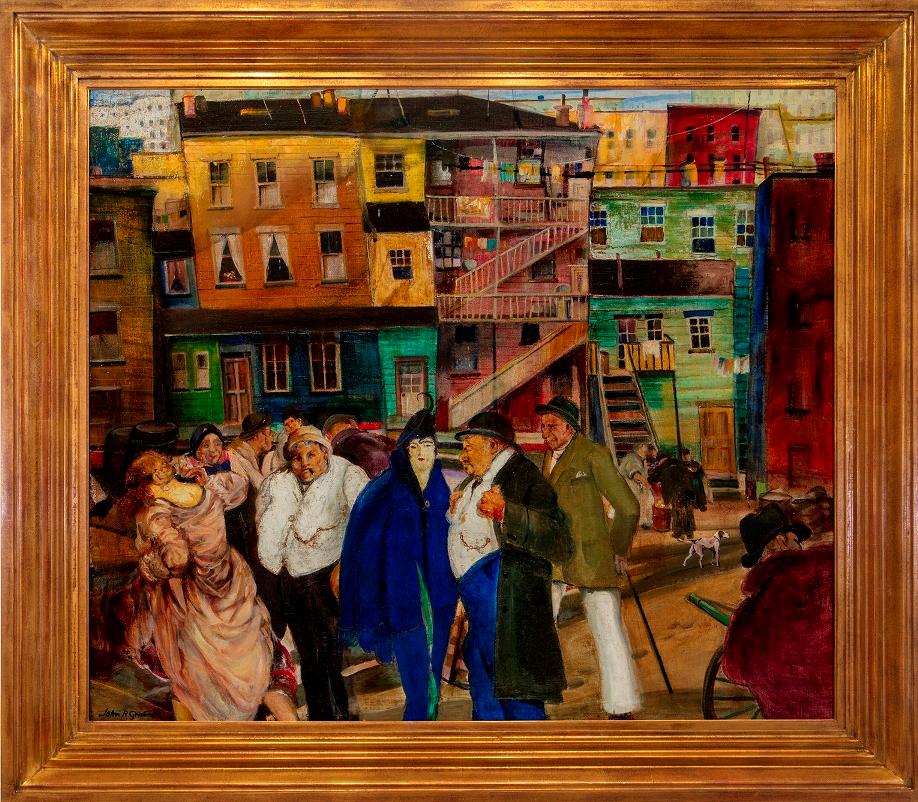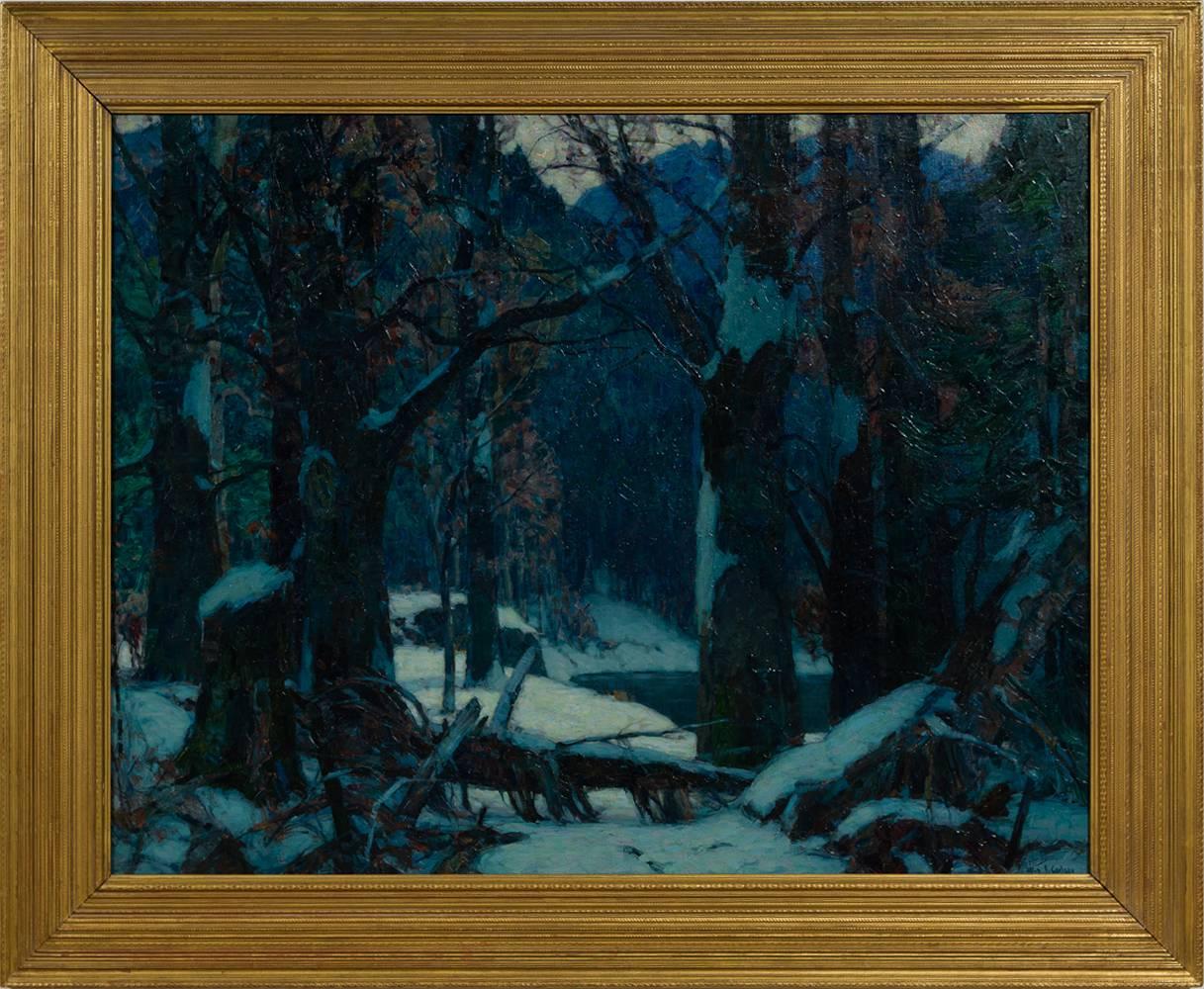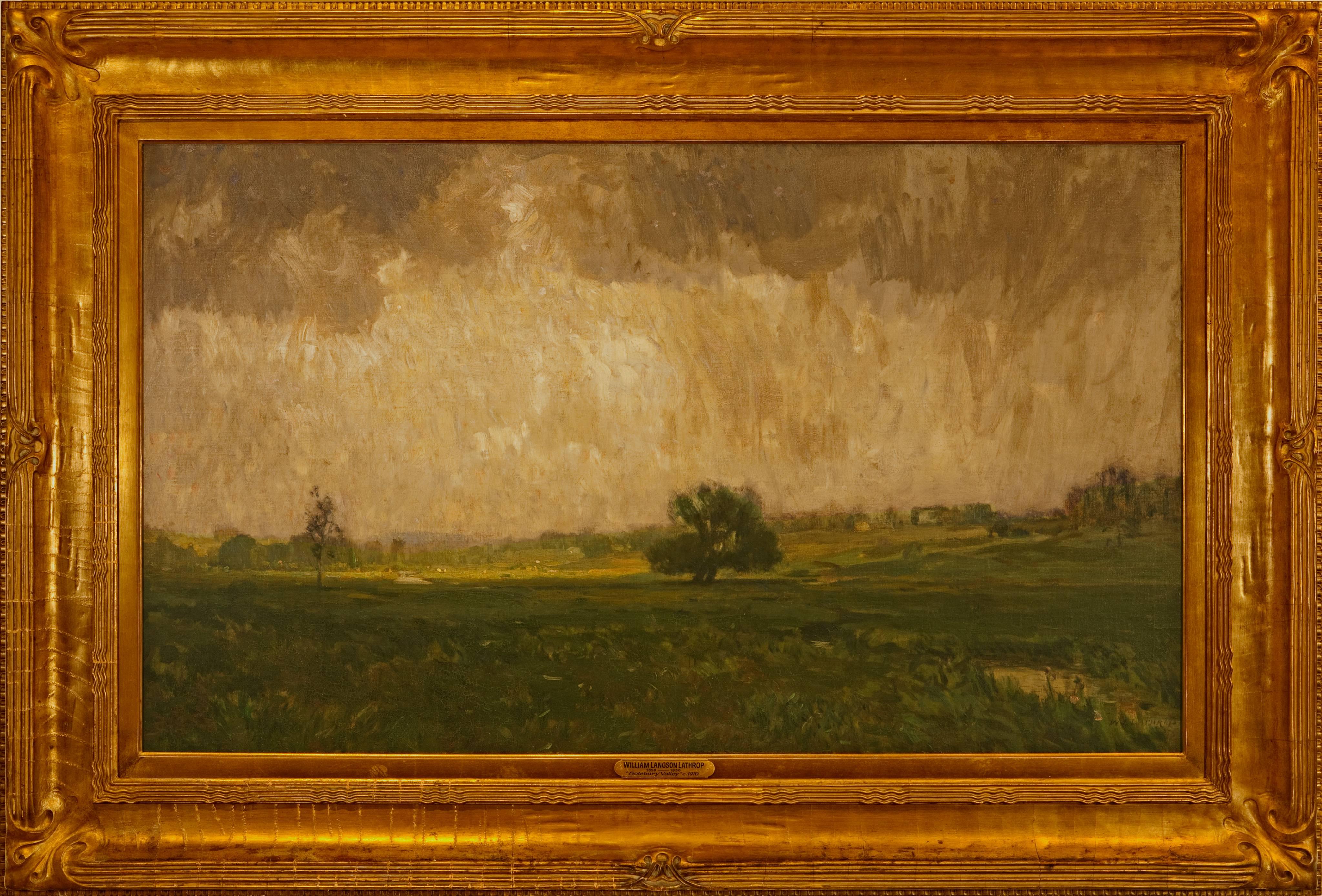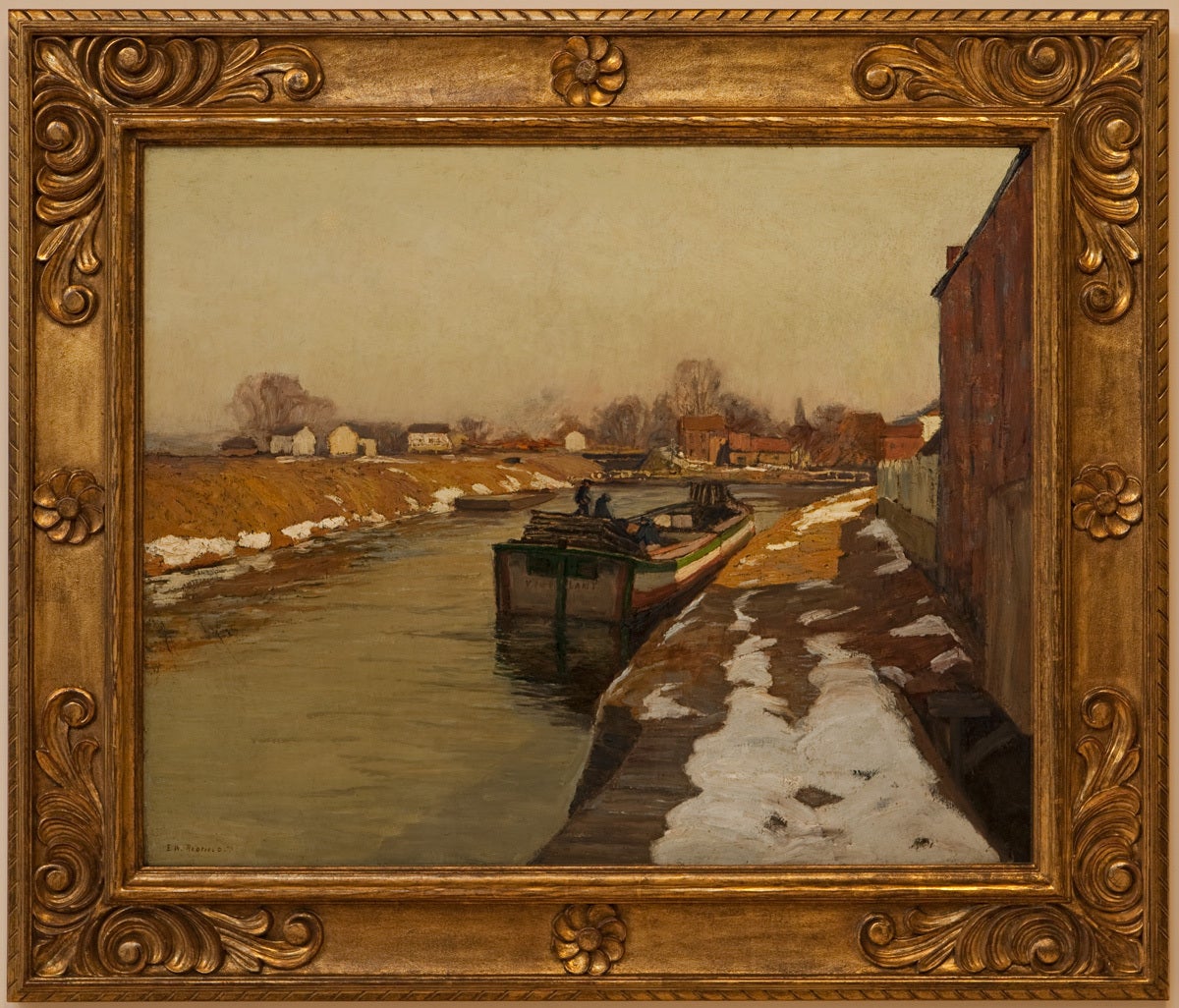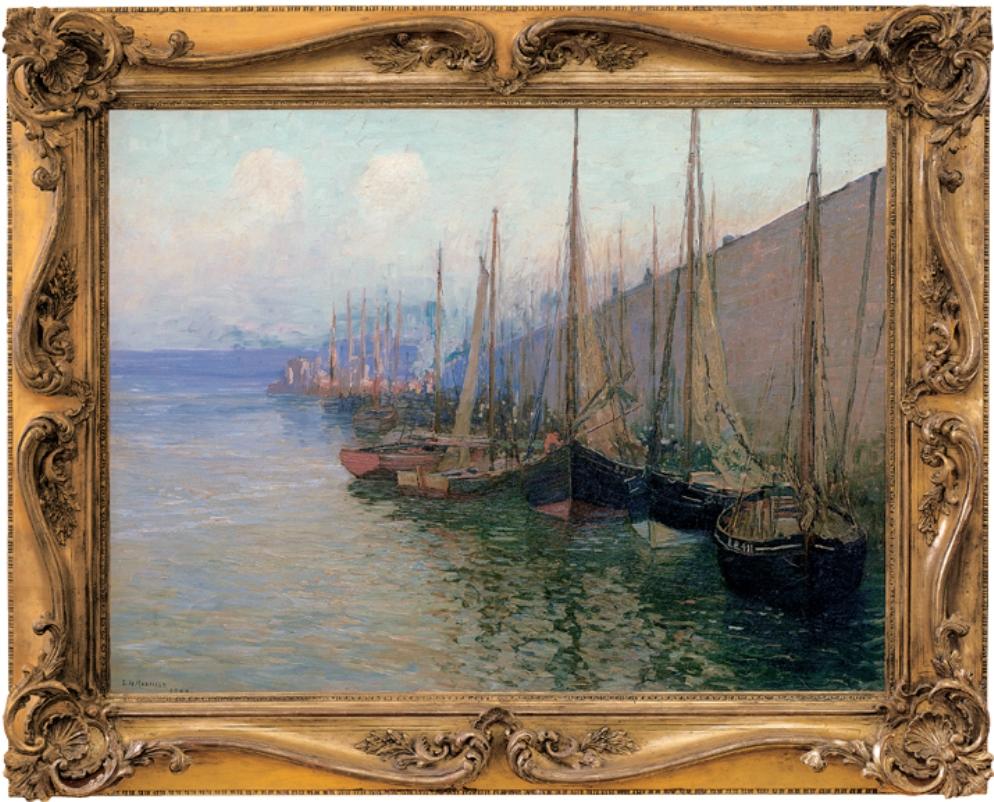Items Similar to "Mountain Lake in Autumn" American Mid Century Oil Painting on Canvas Landscape
Want more images or videos?
Request additional images or videos from the seller
1 of 21
Marie Berger"Mountain Lake in Autumn" American Mid Century Oil Painting on Canvas Landscape20th Century
20th Century
About the Item
A wonderful depiction of mountain lake landscape in the country side. For this beautiful depiction of the mountains, we find distinct elements that are unique to the earlier works of Marie Berger. Among other things, Marie Berger's art is notable for its surrealist elements. In Still Life with Figure in a Desert Landscape, for example, she combines the seemingly incongruous images of a foreground still life composition with the almost infinite lines of perspective of the desert environment. The final result is one of provoking imagery and emotion. With joyful colors, this piece is filled with bold brushstrokes and impressive marks. Comes housed in a gold tone wood frame decorated with finely carved botanical elements and it is ready to hang with wire on verso.
Art measures 16 x 20 inches
Framed measures 19 x 23 inches
A native of Fort Worth, Marie Friedman Berger was born March 9, 1913, the daughter of Will and Minnie Cohen Friedman. She was a graduate of Central High School, now R. L. Paschal, and attended Washington University, St. Louis School of Art. Marie married Jack Henry Berger on June 21, 1939, in Dallas; a marriage that lasted nearly 61 years. Mr. Berger died in 2000. Marie was an internationally renowned artist. Her works have been published by the Metropolitan Art Gallery of New York and shown as one of America's only artists in Italian art galleries. She was a recipient of the annual Benedictine Art Award. For many years she worked along side her late husband operating the Fashion Furniture Gallery on Camp Bowie Blvd.
Marie Berger was a longtime member of Beth-El Congregation and she was also a full member of the Texas Fine Arts Association (Regional Director) and the Texas Watercolor Society. Among the awards presented to her for her art were the Benedictine Award, New York, and the Texas Fine Arts Jurors Award. She also owned and managed the Marie Berger Gallery, Fort Worth, which promoted the works of many rising American and Mexican artists during the 1950's and 1960's. She studied at Texas Christian University, and then at the St. Louis School of Fine Art and at Washington University, Missouri, which was founded as the Saint Louis School and Museum of Fine Arts in 1879 as part of Washington University in St. Louis. Her most common media is the use of oil, acrylic, watercolor, etching, lithograph, collagraph. During her successful career, she exhibited internationally at such institutions as the Bateau Lavar Gallery, Rome, the Rassagna permanente d'arte contemporanea, Veterbo, Italy, the Laguna Gloria, Austin, Texas, the Oklahoma Art Museum and the Fort Worth Art Museum.
Berger died in Fort Worth, Texas in 2001 having exhibited at Bateau Lavar Gallery, Rome; Rassagna permanente d'arte contemporanea, Veterbo, Italy; Oklahoma Art Museum; Wittie Museum of Texas; Fort Worth Art Museum of Texas: Laguna Gloria in Austin Texas. Awards: Benedictine Award of New York; Texas Fine Arts Jurors Award.
PROVENANCE: Lilac Gallery Collection. Signed lower left. This original artwork includes a Certificate of Authenticity issued by the Gallery. The piece will be stamped from Lilac Gallery on its verso.
- Creator:Marie Berger (American)
- Creation Year:20th Century
- Dimensions:Height: 19 in (48.26 cm)Width: 23 in (58.42 cm)Depth: 1 in (2.54 cm)
- Medium:
- Movement & Style:
- Period:
- Condition:This painting is in very good condition besides some ordinary wear from age to the frame which shows some scuffs from age, chips or minor imperfections in line with the manufacturing period.
- Gallery Location:New York, NY
- Reference Number:
About the Seller
5.0
Platinum Seller
These expertly vetted sellers are 1stDibs' most experienced sellers and are rated highest by our customers.
Established in 2012
1stDibs seller since 2015
1,493 sales on 1stDibs
Typical response time: 1 hour
- ShippingRetrieving quote...Ships From: New York, NY
- Return PolicyA return for this item may be initiated within 7 days of delivery.
More From This SellerView All
- "Madison Square on 5th Avenue and 23rd Street" Impressionist Winter Street SceneBy Johann Berthelsen, 1883-1972Located in New York, NYA truly stunning jewel and pertinent example of Berthelsen's charming New York City winter scenes depicting Madison Square Park on 5th Avenue and 23rd Street. An iconic scene that so...Category
Mid-20th Century American Impressionist Landscape Paintings
MaterialsCanvas, Board, Oil
- "Snow by Flatiron" Impressionist Oil Painting Snow Scene Style of Guy WigginsBy Cindy ShaoulLocated in New York, NYA charming depiction of the Flatiron building in New York City with figures in the snow. A cozy impressionistic street scene with colors of cobalts, whites, and burnt sienna's. An ic...Category
2010s American Impressionist Landscape Paintings
MaterialsOil, Canvas
- "By the Seashore" Impressionistic Beach Scene Oil Painting on CanvasBy Cindy ShaoulLocated in New York, NYThis painting depicts an impressionistic scene at the beach with beautiful brushwork and whimsical colors. This piece is filled with capturing colors and thick use of paint, we can f...Category
2010s American Impressionist Landscape Paintings
MaterialsCanvas, Oil
- Walking Through the FieldsBy Kristina NemethyLocated in New York, NYA stunning depiction of a lone figure walking down a path. Nemethy uses a bold impressionistic technique with thick use of paint and wonderful impressions. With joyful colors, this p...Category
Early 2000s American Impressionist Landscape Paintings
MaterialsOil, Canvas
- The Trail to the LakeBy Kristina NemethyLocated in New York, NYA stunning depiction of a path leading down to the lake with mountains in the background. Nemethy uses a bold impressionistic technique with thick use of paint and wonderful impressi...Category
Early 2000s American Impressionist Landscape Paintings
MaterialsOil, Canvas
- "Empire State Building" Impressionist New York City Street Scene Oil PaintingBy Cindy ShaoulLocated in New York, NYThis painting depicts an impressionistic scene of New York City of the Empire State Building from Madison Square Park and 5th Avenue in the summer on a busy day with cars on the stre...Category
2010s American Impressionist Landscape Paintings
MaterialsOil, Canvas
You May Also Like
- "Alley Fiends"By John R. GrabachLocated in Lambertville, NJJim’s of Lambertville is proud to offer this artwork by: John R. Grabach (1886 - 1981) John Grabach was a highly regarded New Jersey artist, teacher, and author of the classic text...Category
1930s American Impressionist Landscape Paintings
MaterialsCanvas, Oil
- "Forest Strongholds"By John F. CarlsonLocated in Lambertville, NJSigned lower right. Complemented by a hand carved and gilt frame. Exhibited at the National Academy of Design, 1928Category
20th Century American Impressionist Landscape Paintings
MaterialsCanvas, Oil
- "Solebury Valley"By William Langson LathropLocated in Lambertville, NJSigned lower right. Complemented by a period frame. William L. Lathrop (1859-1938) Deemed “Father of the New Hope Art Colony”, William Langson Lathrop was born in Warren, Illinois. He was largely self-taught, having only studied briefly with William Merritt Chase in 1887, at the Art Students League. Lathrop first moved east in the early 1880s, and took a job at the Photoengraving Company in New York City. While there, he befriended a fellow employee, Henry B. Snell. The two men became lifelong friends and ultimately, both would be considered central figures among the New Hope Art Colony. Lathrop's early years as an artist were ones of continuing struggle. His efforts to break through in the New York art scene seemed futile, so he scraped enough money together to travel to Europe with Henry Snell in1888. There he met and married an English girl, Annie Burt. Upon returning to New York, he tried his hand at etching, making tools from old saw blades...Category
1910s American Impressionist Landscape Paintings
MaterialsCanvas, Oil
- Winter MoonlightBy George William SotterLocated in Lambertville, NJsigned lower rightCategory
1910s American Impressionist Landscape Paintings
MaterialsCanvas, Oil
- "The Canal"By Edward Willis RedfieldLocated in Lambertville, NJJim’s of Lambertville is proud to offer this artwork. Signed lower left. Complemented by a hand carved and gilt frame. Illustrated in "Edward Redfield: Just Values and Fine Seeing" by Constance Kimmerle and the Pennsylvania Academy of the Fine Arts's Exhibition of Paintings by Edward Redfield (April 17 to May 16, 1909) brochure Edward Willis Redfield (1869 - 1965) Edward W. Redfield was born in Bridgeville, Delaware, moving to Philadelphia as a young child. Determined to be an artist from an early age, he studied at the Spring Garden Institute and the Franklin Institute before entering the Pennsylvania Academy from 1887 to 1889, where he studied under Thomas Anshutz, James Kelly, and Thomas Hovenden. Along with his friend and fellow artist, Robert Henri, he traveled abroad in 1889 and studied at the Academie Julian in Paris under William Bouguereau and Tony Robert-Fleury. While in France, Redfield met Elise Deligant, the daughter of an innkeeper, and married in London in 1893. Upon his return to the United States, Redfield and his wife settled in Glenside, Pennsylvania. He remained there until 1898, at which time he moved his family to Center Bridge, a town several miles north of New Hope along the Delaware River. Redfield painted prolifically in the 1890s but it was not until the beginning of the twentieth century that he would develop the bold impressionist style that defined his career. As Redfield’s international reputation spread, many young artists gravitated to New Hope as he was a great inspiration and an iconic role model. Edward Redfield remained in Center Bridge throughout his long life, fathering his six children there. Around 1905 and 1906, Redfield’s style was coming into its own, employing thick vigorous brush strokes tightly woven and layered with a multitude of colors. These large plein-air canvases define the essence of Pennsylvania Impressionism. By 1907, Redfield had perfected his craft and, from this point forward, was creating some of his finest work. Redfield would once again return to France where he painted a small but important body of work between 1907 and 1908. While there, he received an Honorable Mention from the Paris Salon for one of these canvases. In 1910 he was awarded a Gold Medal at the prestigious Buenos Aires Exposition and at the Panama-Pacific Exposition of 1915 in San Francisco, an entire gallery was dedicated for twenty-one of his paintings. Since Redfield painted for Exhibition with the intent to win medals, his best effort often went into his larger paintings. Although he also painted many fine smaller pictures, virtually all of his works were of major award-winning canvas sizes of 38x50 or 50x56 inches. If one were to assign a period of Redfield’s work that was representative of his “best period”, it would have to be from 1907 to 1925. Although he was capable of creating masterpieces though the late 1940s, his style fully matured by 1907 and most work from then through the early twenties was of consistently high quality. In the later 1920s and through the 1930s and 1940s, he was like most other great artists, creating some paintings that were superb examples and others that were of more ordinary quality. Redfield earned an international reputation at a young age, known for accurately recording nature with his canvases and painting virtually all of his work outdoors; Redfield was one of a rare breed. He was regarded as the pioneer of impressionist winter landscape painting in America, having few if any equals. Redfield spent summers in Maine, first at Boothbay Harbor and beginning in the 1920s, on Monhegan Island. There he painted colorful marine and coastal scenes as well as the island’s landscape and fishing shacks. He remained active painting and making Windsor style furniture...Category
Early 1900s American Impressionist Landscape Paintings
MaterialsCanvas, Oil
- "In Port"By Edward Willis RedfieldLocated in Lambertville, NJJim’s of Lambertville is proud to offer this artwork by: Edward Willis Redfield (1869 - 1965) Edward W. Redfield was born in Bridgeville, Delaware, moving to Philadelphia as a young child. Determined to be an artist from an early age, he studied at the Spring Garden Institute and the Franklin Institute before entering the Pennsylvania Academy from 1887 to 1889, where he studied under Thomas Anshutz, James Kelly, and Thomas Hovenden. Along with his friend and fellow artist, Robert Henri, he traveled abroad in 1889 and studied at the Academie Julian in Paris under William Bouguereau and Tony Robert-Fleury. While in France, Redfield met Elise Deligant, the daughter of an innkeeper, and married in London in 1893. Upon his return to the United States, Redfield and his wife settled in Glenside, Pennsylvania. He remained there until 1898, at which time he moved his family to Center Bridge, a town several miles north of New Hope along the Delaware River. Redfield painted prolifically in the 1890s but it was not until the beginning of the twentieth century that he would develop the bold impressionist style that defined his career. As Redfield’s international reputation spread, many young artists gravitated to New Hope as he was a great inspiration and an iconic role model. Edward Redfield remained in Center Bridge throughout his long life, fathering his six children there. Around 1905 and 1906, Redfield’s style was coming into its own, employing thick vigorous brush strokes tightly woven and layered with a multitude of colors. These large plein-air canvases define the essence of Pennsylvania Impressionism. By 1907, Redfield had perfected his craft and, from this point forward, was creating some of his finest work. Redfield would once again return to France where he painted a small but important body of work between 1907 and 1908. While there, he received an Honorable Mention from the Paris Salon for one of these canvases. In 1910 he was awarded a Gold Medal at the prestigious Buenos Aires Exposition and at the Panama-Pacific Exposition of 1915 in San Francisco, an entire gallery was dedicated for twenty-one of his paintings. Since Redfield painted for Exhibition with the intent to win medals, his best effort often went into his larger paintings. Although he also painted many fine smaller pictures, virtually all of his works were of major award-winning canvas sizes of 38x50 or 50x56 inches. If one were to assign a period of Redfield’s work that was representative of his “best period”, it would have to be from 1907 to 1925. Although he was capable of creating masterpieces though the late 1940s, his style fully matured by 1907 and most work from then through the early twenties was of consistently high quality. In the later 1920s and through the 1930s and 1940s, he was like most other great artists, creating some paintings that were superb examples and others that were of more ordinary quality. Redfield earned an international reputation at a young age, known for accurately recording nature with his canvases and painting virtually all of his work outdoors; Redfield was one of a rare breed. He was regarded as the pioneer of impressionist winter landscape painting in America, having few if any equals. Redfield spent summers in Maine, first at Boothbay Harbor and beginning in the 1920s, on Monhegan Island. There he painted colorful marine and coastal scenes as well as the island’s landscape and fishing shacks. He remained active painting and making Windsor style furniture...Category
Early 1900s American Impressionist Landscape Paintings
MaterialsCanvas, Oil
Recently Viewed
View AllMore Ways To Browse
Used Furniture Gallery
American Painting Gold Frame
Early American Landscape Oil Paintings
21 Century Paintings
American Landscape 20th Century Painting Oil
American Mountain Landscapes
American Mid Century Oil Paintings
American Midcentury Oil Painting
Native American Oil Painting
Oil Painting Of Native American
American Impressionist Landscapes 20th Century
Oil On Canvas From Early 20th Century
Beautiful Mid Century Oil Paintings
Oil Lake Landscape
Midcentury Etching
19 Century American Art
New Mexico Landscape Oil
New Mexico Landscape Oil Paintings
